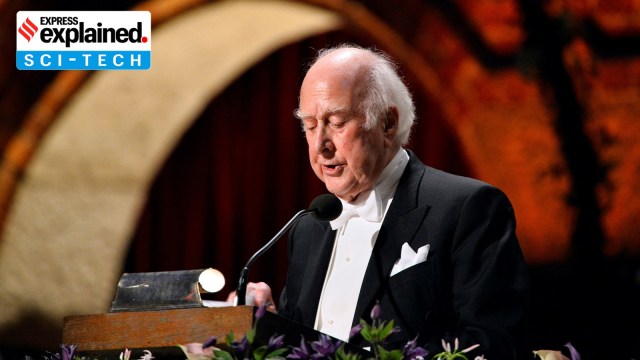Physicist Peter Higgs passes away: What is the ‘God particle’, which he theorised in 1960s?
The 'God particle' or Higgs boson is the particle that is supposed to account for the mass of every other fundamental particle. What does that mean? Here is a look.
 Nobel physics laureate Peter Higgs addresses the traditional Nobel gala banquet at the Stockholm City Hall, December 10, 2013. (REUTERS/file)
Nobel physics laureate Peter Higgs addresses the traditional Nobel gala banquet at the Stockholm City Hall, December 10, 2013. (REUTERS/file)It required nearly 50 years, and the world’s biggest and most complex machine, to detect the Higgs boson in 2012. An elementary particle like electrons, quark, photons or neutrinos, the Higgs boson, is known to impart mass to every other particle. Its existence was predicted in the 1960s, but it was found only in 2012 through elaborate experiments carried out at the Large Hadron Collider, located on the border of France and Switzerland, the world’s biggest and most expensive machine till then.
The discovery of the Higgs boson completed what is known as the Standard Model of Particle Physics, which describes all the fundamental particles, like electrons and protons, and the forces, like electromagnetism, gravitation or nuclear forces, that build up the material part of the world.
Of course, there are still-unexplained bits like dark matter or dark energy that are outside the realm of Standard Model.
As elusive as the particle
The man, after whom the particle is named, Peter Higgs, died on Tuesday (April 9) aged 94. An extremely shy person, Higgs, who had started out as a molecular biologist, preferred to work in isolation and was not a prolific contributor.
The prediction of the Higgs field and the Higgs boson was the only major work he did, producing just about a dozen papers in his entire career, only one of which had a co-author. Till his end, Higgs never used a mobile phone or internet, the landline at his home in Edinburgh the only way to reach him.
Having had a first-hand glimpse at the media frenzy when the announcement of the discovery of Higgs boson was made in July 2012 at CERN in Switzerland, Higgs did a disappearing act on the day the Nobel Prize in Physics was announced the next year.
Almost certain that he would figure on the list, and desperately hoping to avoid the limelight and attention that would inevitably follow, Higgs, who was 82 at the time, left his home, wandered on the streets of Edinburgh, had food at one of his favourite restaurants and visited an art exhibition.
So much so that the Nobel Prize Committee, which informs the winners just ahead of the public announcement, wasn’t able to reach him, and had to go ahead with the announcement after half an hour delay. Higgs was informed about the news by a former neighbour who happened to find him strolling on the road and stopped her car to tell him about it.
Higgs was not the only one behind the prediction of the particle and the field that got named after him. Several people contributed to the idea, and one of them, Francois Englert, shared the 2013 Physics Nobel Prize with him.
God Particle
Much of the hype surrounding the Higgs boson amongst the common people comes from the fact that it got dubbed as the ‘God particle’. The expression was first used by Nobel Prize winning physicist Leon Lederman who wrote a book by that title in the 1990s about the continuing search for the Higgs boson.
Lederman wanted to call his book ‘The Goddamn Particle’ to describe the elusive nature of the Higg’s boson, but was persuaded by the publishers to go in for the God particle, a name that stuck. Many scientists detest that expression, mainly because the particle acquired religious connotations in some circles because of that name.
Mass
Boson is the name given to a family of elementary particles that are known to be carriers of fundamental forces like electromagnetism. Photon, which carries the electromagnetic force, is a boson. On the other hand, the matter particles, like electron or protons, belong to the class called fermions.
The big significance of Higgs boson is that it is the particle that is supposed to account for the mass of every other fundamental particle. Strange as it appears, mass is not something that is intrinsic to matter. Fundamental particles of matter like electrons or protons do not have mass within themselves. In the 1950s and 1960s, when the Standard Model was still being developed, scientists realised that the equations did not work if these particles had inherent mass.
It was a mathematical problem that Higgs and several other scientists worked upon. In 1964, the same year the Big Bang theory got firmly established, they separately developed the idea of an all-pervasive field, just like there is an electric filed or a magnetic or gravitational field, in which a massless particle could gain mass.
The pre-eminence that Higgs received was mainly due to the fact that he alone postulated that this mathematical construct, if it indeed was physical reality, would give rise to a particle, the eventual Higgs boson.
As it became clear later, it is the interaction of the particles with this Higgs field — the way they change the field or get changed by them — that lends them the mass. Greater the interaction, larger is the mass. Different particles interact with this field in different ways, and that is what gives them different masses.
A photon, which is a light particle, does not interact with this field at all, and is thus massless. There are other particles that are massless as well. But particles like electrons and protons, do interact, and have masses. The Higgs boson itself interacts with this field, and thus has mass.
The concepts of Higgs field and Higgs particle are not very intuitive, but these are fundamental to our current understanding of the way nature works.
The main fame for Higgs boson came from its elusive nature. Scientists kept frantically searching for it for more than four decades but could not find it. One of main science objectives of the LHC, which is the world’s biggest particle accelerator and cost about US$ 9 billion to build, was to find the Higgs boson. It did, within the first four years of its operations, and that remains one of its crowning glories till now.
- 01
- 02
- 03
- 04
- 05






































